Recently I was asked about why orchids sometimes just go belly up and how to avoid it. I actually get this question a lot, and finally the light bulb blinked on - post it to the blog so everyone can read it! Silly me. So what follows is my long-winded answer. Hope you find it useful!
I maintain that orchids are not difficult, they're just different. Different rules. And the fact is that people are often exposed to discount store plants that have received poor care...which reinforces the idea that they're difficult.
The most commonly seen problem with Phalaenopsis is plant collapse or withering leaves, which typically is one of two things: (1) water stress, (2) rot disease.
(1) Water stress can be either too often or way to infrequent watering. I'm sure you can see how too little water leaves to dessicated leaves. But too frequent watering or media that stays wet too long can result in an appearance that looks the same because it can lead to the roots rotting. No roots means nothing to take in water with, so the leaves can't survive.
Most orchids, phalaenopsis included, are epiphytes, and live in areas where they camp out on trees. They get plenty of rain, but its breezy up in a tree so they dry off pretty often too. So in a pot they need a porous mix that holds air and water. It also helps to make sure they're snug in their pot (root bound), which reduces the amount of stagnant moisture in the pot.
Water well when its time to water, then let them dry out a bit before watering again. Stick your finger in the pot and feel around. Should be dry at least 2 inches down, then water well again. Also don't let them sit in water (if they're really dry, you can do that for maybe 20min, but not for a day or more like you can do with some plants). Some people put these things in what looks like regular potting soil. I personally think this is a recipe for trouble because it can stay so wet.
When you pick a plant, look for one with lots of hard white (or silver) roots with green (or purple) tips. If you grab it by the leaves, it should be stable and should bring the whole pot with it, within reason. If its freshly potted, or a slipper orchid, or in a heavy clay pot it might not, but it should still feel firmly associated with that pot.
To check for root problems, yank that thing out of the pot and look at the roots. They should be firm and kinda white. If they're dark brown and squishy, there's a problem.
(2) Other rot diseases are less common, but do happen. Again using the example of the Phalaenopsis, if water sits in the crown of the plant, this can lead to fungus or bacterial rots that will kill the center of the plant and the whole thing will collapse. How to avoid this? (a) Don't bother with misting your plants, (b) when you water, just water the media and not the leaves, (c) if you water with a hose (say in a greenhouse), make sure there's a fan that moves air about so the leaves dry off.
Sunday, March 30, 2008
In Bloom: Restrepia sanguinea 'Bloody Hopeful'
 This is a young Restrepia sanguinea that I have decided to call "Bloody Hopeful" for two reasons.
This is a young Restrepia sanguinea that I have decided to call "Bloody Hopeful" for two reasons. First, both words are definitions for sanguine along with it indicating red color.
Second, this flower is absolutely huge for a restrepia with a ventral sepal of 3.5cm and a total natural vertical spread of 6cm (keeping in mind that it is not flat, so its bigger than that suggests). It is the largest restrepia flower I've ever seen. According to ISOPE, typical size for the flower is 3cm! So I'm hopeful that if I can take it to judging I might get a flower quality award. I hope it holds out until next Saturday!
Part of me worries if this is a fluke though. It only has one flower on it right now. It has bloomed before but I don't remember if it was this large. Could I have possibly missed it? Of course, its possible that my culture has been marginally better lately. Lets hope its that.
Saturday, March 29, 2008
2008 South East Pennsylvania Orchid Society Show
Below is a selection of my photos of plants on display. Please note judging was still in progress when I was there, so I don't know who owns most of the plants shown.
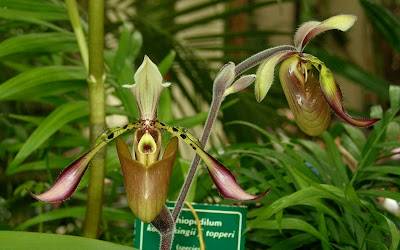
Paph. richardianum, displayed by Piping Rock Orchids. This species was/is (?) a variety of lowii. This one is on my wish list!! I didn't notice any on Piping Rock's sale table, but I'm going to check their website to see if they might have any available.
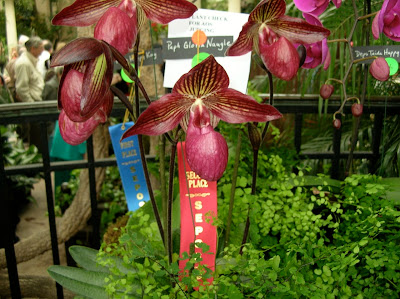
This is a Paph. Gloria Naugle displayed by Krull-Smith. Gloria Naugle is the sort of thing I don't normally like, and I've seen a few of them that I didn't like, but this one is quite nice. Strong, even color, lots of shine, good size and consistent form.
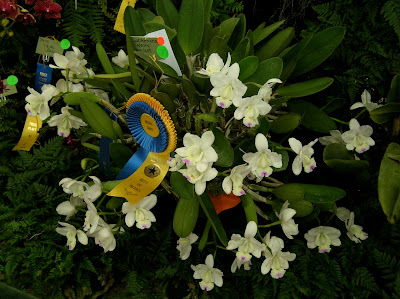
A very excellently grown plant of Cattleya walkeriana 'Kenny' AM/AOS, a semi-alba clone. The plant was huge, as in CCM sized. It maybe didn't get that CCM at this show, though, since a few of the flowers were a bit banged up from a rough trip. But I bet it will on the next blooming.

One of my very favorite Cyps, Cypripedium parviflorum var. pubescens. Makes me wish I had woodland habitat in my yard.
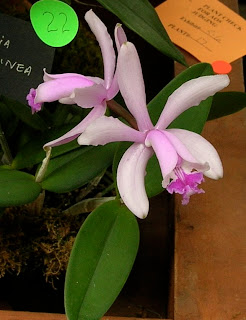
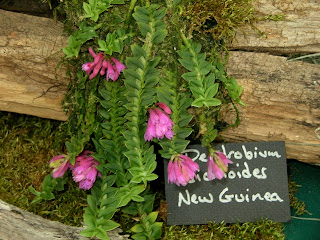
Cattleya intermedia var. sanguinea (left) and Dendrobium dichaeoides (bottom).
Labels:
orchid show photos,
orchids,
paphs
Thursday, March 27, 2008
Proper Use of a Couch
 Three of our four cats modeling the accepted positions when using a couch. Top to bottom we have Linus, Duncan, and Fat Cat (doing what he does best).
Three of our four cats modeling the accepted positions when using a couch. Top to bottom we have Linus, Duncan, and Fat Cat (doing what he does best).And here is Duncan demonstrating the proper use of the arm of the couch.

Labels:
assorted cats and pets
Tuesday, March 25, 2008
In Bloom: Automagically
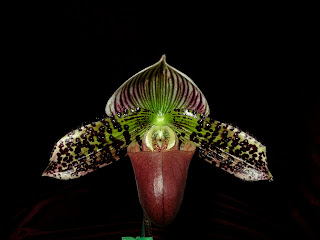 This is Paph. (Zellwood Station x Hsinying Maru) 'Automagically'.
This is Paph. (Zellwood Station x Hsinying Maru) 'Automagically'.I recently saw this at my buddy Al's place and had to have it. Ok, no doubt some of you out there are saying "Yeah, ok, what's the excitement? That's pretty average looking." Well, yeah, it is pretty average. Its big, but other than that it is a typical coloratum maudiae type paph and its a bit cupped.
But that's not what made it exciting. Check out the photo below!
 Woah! It has wings!
Woah! It has wings!Al had a whole batch of this cross. All were jumbo sized but only a couple had these odd little appendages. This one had the biggest appendages. I scooped it up so I could see if it was a fluke or if it would bloom that way every time.
Special Note: Al's greenhouse recently had a disaster. I don't have any details at this time but I'm sure he will update everyone via the website when he has time. I hope everyone will join me in wishing him strength. Al's greenhouse was a joy to visit and he always has neat stuff. I hope he is able to rebuild.
Wednesday, March 19, 2008
Who's the Daddy?
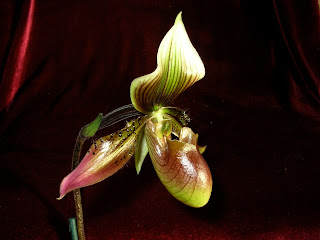 This is Paph. Puck's Apple. Its a pretty large flower, and with that name we know it must have appletonianum in the background. Its other parent was Mod Maude. This picture isn't great, but I'm sure you get the general idea.
This is Paph. Puck's Apple. Its a pretty large flower, and with that name we know it must have appletonianum in the background. Its other parent was Mod Maude. This picture isn't great, but I'm sure you get the general idea.I've decided to pollinate it but can't choose between two possible pollen donors. Yeah, yeah, the shape isn't perfect, but I'm not concerned about that. It has some interesting genetics to offer.
 Anyway, I've decided I'd like to use either my seedling of Paph. gardineri, which is the second photo here, or my Paph. venustum var. pardhanii which can be seen in this post. The gardineri can offer two things of interest: (a) possible multifloral tendencies, and (b) an enhancement to make the slight twist of Puck's Apple's petals look "on purpose." The venustum offers (a) possible increase in color contrasts of the flower while maintaining strong color on the petal ends, (b) possible brains patterning on the pouch, which is always cool. I think they both offer general niftiness.
Anyway, I've decided I'd like to use either my seedling of Paph. gardineri, which is the second photo here, or my Paph. venustum var. pardhanii which can be seen in this post. The gardineri can offer two things of interest: (a) possible multifloral tendencies, and (b) an enhancement to make the slight twist of Puck's Apple's petals look "on purpose." The venustum offers (a) possible increase in color contrasts of the flower while maintaining strong color on the petal ends, (b) possible brains patterning on the pouch, which is always cool. I think they both offer general niftiness. So far I've had one vote for each possible parent. Please give me a tie breaker!! What should I choose? And we need to decide quick, paphs take pollen best when the flowers are pretty fresh.
Labels:
hybridization,
in bloom,
orchids,
paphs,
plants
Tuesday, March 18, 2008
In bloom: A first bloom Paph seedling
 This is Paph. (hainanense x wolterianum), a cute little seedling blooming for the first time. The flower is small and delicate, about 2 or 2.5 inches across. It might get a tiny bit bigger on the next blooming although I suspect not much. But even though it is small, it is very cute in person. Last night it got a third place ribbon in the First Bloom Seedling class at the National Capitol Orchid Society (NCOS) meeting. It might have done better, but it flipped over in the car so it was a little chewed by the time we got there. oops. Still cute though!!
This is Paph. (hainanense x wolterianum), a cute little seedling blooming for the first time. The flower is small and delicate, about 2 or 2.5 inches across. It might get a tiny bit bigger on the next blooming although I suspect not much. But even though it is small, it is very cute in person. Last night it got a third place ribbon in the First Bloom Seedling class at the National Capitol Orchid Society (NCOS) meeting. It might have done better, but it flipped over in the car so it was a little chewed by the time we got there. oops. Still cute though!!Monday, March 17, 2008
Traditions by Debbie Mumm - UPDATE
 UPDATE!
UPDATE!A while back I wrote a yarn review of Transitions by Debbie Mumm. At the time I was not very satisfied with the yarn. I'm still not excited about its noodley ways, but it is soft and subtly colored. A number of other Ravelry users have also commented about this yarn's crankiness, but many more have pressed on to create very nice things with it. I decided to be brave, put aside my bias, and go for it.
And so yesterday I finished these fingerless mittens. They're yummy soft! Also, in honor of the EtsyFAST March Fairy Tale Challenge I've named them for The Snow Queen. Don't they remind you of shadows on the snow in mid-January? ooo...chilly!! Quick, grab your gloves! :)
The yarn did continue to be slightly irritating, but you just keep pushing the squiggle down the line, smoothing the section you're knitting with as you go. If it gets too bad, cut it and re-attach a smooth section.
Labels:
fiber art,
knitting,
yarn review
Sunday, March 16, 2008
In bloom: Comparison of Paph. venustum varieties
Actually, I have lots of stuff in bloom now. Its that time of year. But for the moment I'm going to post 2 Paph venustum plants.
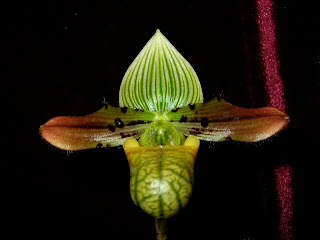 The first photo is a straight Paph. venustum, which I got last year from The Little Greenhouse. It has a nice form which is pretty flat. Many venustums have reflexed petals. She's a keeper!
The first photo is a straight Paph. venustum, which I got last year from The Little Greenhouse. It has a nice form which is pretty flat. Many venustums have reflexed petals. She's a keeper!
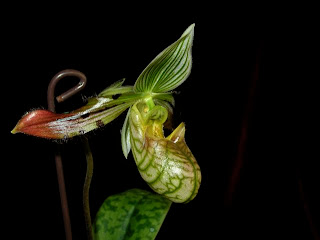 The second plant is Paph. venustum var. pardhanii, and came from Parkside Orchids just this past Paph Forum. (you can't beat instant gratification). There are many venustum varieties, and I own several seedlings, but I haven't actually seen very many blooming in person. This variety is supposed to be more colorful or have stronger color, and it does. It was difficult to capture, but the venustum above has sort of a brown shade on the petals and only yellow and green on the pouch. This pardhanii has definite a red shade on the petals and the pouch has a hinting of this color too. Form is obvously reflexed, but it is still an attractive little flower.
The second plant is Paph. venustum var. pardhanii, and came from Parkside Orchids just this past Paph Forum. (you can't beat instant gratification). There are many venustum varieties, and I own several seedlings, but I haven't actually seen very many blooming in person. This variety is supposed to be more colorful or have stronger color, and it does. It was difficult to capture, but the venustum above has sort of a brown shade on the petals and only yellow and green on the pouch. This pardhanii has definite a red shade on the petals and the pouch has a hinting of this color too. Form is obvously reflexed, but it is still an attractive little flower.
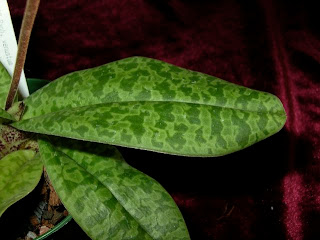 And as a bonus, the foliage on venustum is always really attractive!
And as a bonus, the foliage on venustum is always really attractive!
 The first photo is a straight Paph. venustum, which I got last year from The Little Greenhouse. It has a nice form which is pretty flat. Many venustums have reflexed petals. She's a keeper!
The first photo is a straight Paph. venustum, which I got last year from The Little Greenhouse. It has a nice form which is pretty flat. Many venustums have reflexed petals. She's a keeper! The second plant is Paph. venustum var. pardhanii, and came from Parkside Orchids just this past Paph Forum. (you can't beat instant gratification). There are many venustum varieties, and I own several seedlings, but I haven't actually seen very many blooming in person. This variety is supposed to be more colorful or have stronger color, and it does. It was difficult to capture, but the venustum above has sort of a brown shade on the petals and only yellow and green on the pouch. This pardhanii has definite a red shade on the petals and the pouch has a hinting of this color too. Form is obvously reflexed, but it is still an attractive little flower.
The second plant is Paph. venustum var. pardhanii, and came from Parkside Orchids just this past Paph Forum. (you can't beat instant gratification). There are many venustum varieties, and I own several seedlings, but I haven't actually seen very many blooming in person. This variety is supposed to be more colorful or have stronger color, and it does. It was difficult to capture, but the venustum above has sort of a brown shade on the petals and only yellow and green on the pouch. This pardhanii has definite a red shade on the petals and the pouch has a hinting of this color too. Form is obvously reflexed, but it is still an attractive little flower. And as a bonus, the foliage on venustum is always really attractive!
And as a bonus, the foliage on venustum is always really attractive!
Monday, March 10, 2008
2008 Maryland Orchid Society Show
A selection of things I felt compelled to photograph at this year's MOS Show and Sale, held this past weekend.

The display prepared by Steve and Rachel Adams and a closeup of their Paph. delenatii group below.
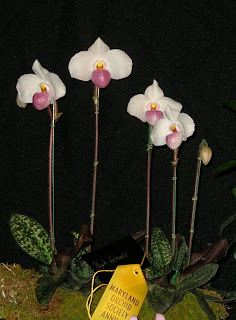
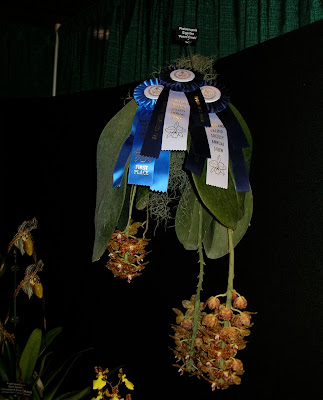
An impressive specimen of Phal. gigantea 'Penns Creek' grown by Woodstream Orchids.

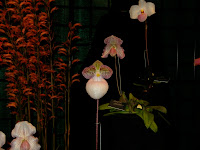

Left to right: Paph. Julius x stonei, Paph. micranthum, and Lycaste Shoal Haven. All presented by Fishing Creek Orchids.
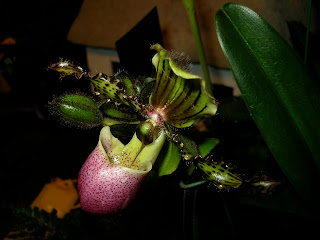

A nice example of Paph. chamberlainianum var. latifolium shown by Patti Kelt, and an interesting hybrid phal, Dtps. (Taisuco Jewel x King Magic), shown by Eric Wiles & Becky Weiler. Yes, it was pretty red.
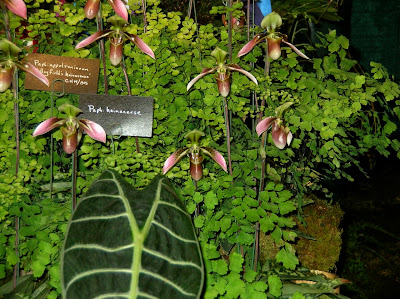
An elegant group of Paph. hainanense and some appletonianum grown by The Little Greenhouse. Little Greenhouse always makes a fantastic display, getting a little pile of awards, trophies, and AOS awards for their trouble.
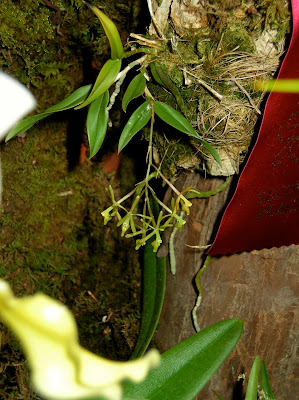 Epidendrum conopseuim grown by David Smith. I learned at the show that this species is the most cold hardy North American epiphytic orchid, growing as far north as South Carolina. That's inside zone 7!
Epidendrum conopseuim grown by David Smith. I learned at the show that this species is the most cold hardy North American epiphytic orchid, growing as far north as South Carolina. That's inside zone 7!

The display prepared by Steve and Rachel Adams and a closeup of their Paph. delenatii group below.


An impressive specimen of Phal. gigantea 'Penns Creek' grown by Woodstream Orchids.



Left to right: Paph. Julius x stonei, Paph. micranthum, and Lycaste Shoal Haven. All presented by Fishing Creek Orchids.


A nice example of Paph. chamberlainianum var. latifolium shown by Patti Kelt, and an interesting hybrid phal, Dtps. (Taisuco Jewel x King Magic), shown by Eric Wiles & Becky Weiler. Yes, it was pretty red.

An elegant group of Paph. hainanense and some appletonianum grown by The Little Greenhouse. Little Greenhouse always makes a fantastic display, getting a little pile of awards, trophies, and AOS awards for their trouble.
 Epidendrum conopseuim grown by David Smith. I learned at the show that this species is the most cold hardy North American epiphytic orchid, growing as far north as South Carolina. That's inside zone 7!
Epidendrum conopseuim grown by David Smith. I learned at the show that this species is the most cold hardy North American epiphytic orchid, growing as far north as South Carolina. That's inside zone 7!
Labels:
orchid show photos,
orchids,
paphs,
phals
Subscribe to:
Posts (Atom)
